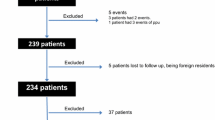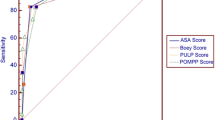Abstract
Three hundred and three consecutive patients operated on for peptic ulcer for the first time between 1 January 1984 and 31 December 1993 were evaluated in this retrospective study. Eleven variables (Period when operation took place, gender, smoking behaviour, history of former ulcers, ulcerogenic drug intake, ulcer location, epigastric pain, number of blood units substituted, patient's age, type of operation, comorbidity) were investigated regarding their influence on peri- and post-operative mortality and on the length of hospital stay after operation. We found that a high comorbidity score (>2) and the indication “emergency operation” (vs “elective operation”) had an adverse impact on survival. The importance of age was marginal. The duration of post-operative hospital stay in survivors was negatively influenced by age higher than 60 years, more than two red cell units substituted and a high comorbidity score according to Charlson.
Zusammenfassung
In dieser retrospektiven Studie wurden im Zeitraum zwischen dem 1.1.1984 und dem 31.12.1993 303 operativ behandelte Ulkuspatienten erfaßt. Elf potentielle Einfluβgröβen (Zeitraum der Operation, Geschlecht, Raucherverhalten, Ulkusanamnese, Einnahme ulzerogener Medikamente, Ulkuslokalisation, Magenschmerz, Anzahl der substituierten Blutkonserven, Alter der Patienten, Operationsindikation, Komorbidität) wurden hinsichtlich ihres Einflußes auf die peri- und postoperative Sterblichkeit sowie die Krankenhausverweildauer untersucht. Hohe Komorbidität (>2) und die Indikation “Notfalloperation” (gegen elektive Operation) zeigten einen negativen Einfluß hinsichtlich des Überlebens. Dem Alter kam nur eine geringe Bedeutung zu. Die postoperative Aufenthaltsdauer wurde hauptsächlich durch hohes Alter (>60 Jahre), eine hohe Anzahl (>2) substituierter Blutkonserven und einen hohen Komorbiditätsscore nach Charlson negativ beeinflußt.
Similar content being viewed by others
References
Agrez MV, Henry DA, Senthiselvan S, Duggan JM (1992) Changing trends in perforated peptic ulcer during the past 45 years. Aust NZ J Surg 62:729–732
Allen R, Dykes P (1976) A study of factor influencing mortality rates from gastrointestinal haemorrhage. Q J Med 180:533–550
Armstrong CP, Blower AL (1987) Non-steroidal anti-inflammatory drugs and life threatening complications of peptic ulceration. Gut 28:527–532
Bender JS, Bouwman DL, Weaver DW (1994) Bleeding gastroduodenal ulcers: Improved outcome from a unified surgical approach. Am Surg 60:313–315
Boey J, Choi SKY, Alagaratnam TT, Poon A (1987) Risk stratification in perforated duodenal ulcers. A prospective validation of predictive factors. Ann Surg 205:22–26
Charlson ME, Pompei P, Ales KL, MacKenzie RC (1987) A new method of classifying prognostic comorbidity in longitudinal studies: development and validation. J Chron Dis 40:373–383
Collier DSTJ, Pain JA (1985) Non-steroidal anti-inflammatory drugs and peptid ulcer perforation. Gut 26:359–363
Demartines N, Rothenbühler J-M, Chevalley J-P, Harder F (1991) La chirurgie d'urgence en cas d'ulcère gastro-duodenal perforé. Helv Chir Acta 58:783–787
Donaldson GA, Jarrett F (1970) Perforated gastroduodenal ulcer disease at the Massachusetts General Hospital from 1952 to 1970. Am J Surg 120:306–311
Ell C, Hagenmüller F, Schmitt W, Riemann JF, Hahn EG, Hohenberger W (1995) Multizentrische prospektive Untersuchung zum aktuellen Stand der Therapie der Ulkusblutung in Deutschland. Dtsch Med Wochenschr 120:3–9
Fallahzadeh H (1993) Elective procedure for peptic ulcer: a disappearing operation. Am Surg 59:20–22
Forbes GM, Glaser ME, Cullen DJE et al (1994) Duodenal ulcer treated withHelicobacter pylori eradication: seven-year follow-up. Lancet 343:258–260
Graham DY, Hepps KS, Ramirez FC, Lew GM, Saeed ZA (1993) Treatment ofHelicobacter pylori reduces the rate of rebleeding in peptic ulcer disease. Stand J Gastroenterol 28:939–942
Gunshefski L, Flancbaum L, Brolin RE, Frankel A (1990) Changing pattern in perforated peptic ulcer disease. Am Surg 56:270–274
Gustavson S, Kelly KA, Melton III LJ, Zinsmeister AR (1988) Trends in peptic ulcer surgery. A population-based study in Rochester, Minnesota, 1956–1985. Gastroenterology 94:688–694
Hamby LS, Zweng TN, Strodel WE (1993) Perforated gastric and duodenal ulcer: an analysis of prognostic factors. Am Surg 59:319–324
Hosmer DW, Lemeshow S Jr (1989) Applied logistic regression. Wiley, New York, pp 25–27
Imhof M, Ohmann C, Verreet PR, Röher HD, DÜSUK-Studien-gruppe (1995) Operative Therapie beim unkompliziertem Ulcus: Ergebnisse einer prospektiven epidemiologischen Studie. Z Gastroenterol 33:381–384
Irvin TT (1989) Mortality and perforated peptic ulcer: a case for risk stratification in elderly patients. Br J Surg 76:215–218
Ishikawa M, Kikutsuji T, Miyauchi T, Sakakihara Y (1994) Limitations of endoscopic haemostasis by ethanol injection and surgical management for bleeding peptic ulcer. J Gastroenterol Hepatol 9:64–68
Jick SS, Perera DR, Walker AM, Jick H (1987) Non-steroidal anti-inflammatory drugs and hospital admission for perforated peptic ulcer. Lancet II:380–382
Keating J, Chandran H (1992) Antiinflammatory drugs and emergency surgery for peptic ulcers in the Waikato. NZ Med J 105:127–129
Knaus WA, Draper EA, Wagner DP, Zimmermann JE (1985) Apache II: a severity of disease classification system. Crit Care Med 13:818–829
Kurata JH, Corboy ED (1988) Current peptic ulcer time trends. An epidemiological profile. J Clin Gastroenterol 10:259–268
Laine L, Peterson WL (1994) Bleeding peptic ulcer. N Engl J Med 331:717–727
Lawless IF (1982) Statistical models and methods for life time data. Wiley, New York, pp 343–345
Lehnert T, Herfarth C (1993) Peptic ulcer surgery in patients with liver cirrhosis. Ann Surg 217:338–346
Lorenz W, Dick W, Junginger T, Ohmann C, Doenicke A, Rothmund M (1987) Biomedizinische und klinimetrische Ansätze in der Ursachenforschung beim perioperativen Risiko: Erstellung einer deutschen ASA-Klassifikation. Langenbecks Arch Chir 372:199–209
McAleese P, Odling-Smee W (1994) The effect of complications on length of stay. Ann Surg 220:740–744
McGuire HH, Horsley III JS (1986) Emergency operations for gastric and duodenal ulcers in high risk patients. Ann Surg 203:551–556
Morris DL, Hawker PC, Brearley S, Simmes M, Dykes PW, Keighley MRB (1984) Optimal timing of operation for bleeding peptic ulcer: prospective randomized trial. Br Med J 288:1277–1280
Mosnier H, Farges O, Vons C, Belghiti J, Fekété F (1992) Gastroduodenal ulcer perforation in the patient with cirrhosis. Surg Gynecol Obstet 174:297–301
Mueller X, Rothenbühler J-M, Amery A, Harder F (1993/94) Facteurs de risque d'hémorrhagie persistante on récidivante et de mortalité des ulcères peptiques hémorrhagiques. Helv Chir Acta 60:661–664
Paimela H, Joutsi T, Kiviloto T, Kivilaakso E (1995) Recent trends in mortality from peptic ulcer disease in Finland. Dig Dis Sci 40:631–635
Rabeneck L, Feinstein AR, Horwitz RI, Wells CK (1993) A new clinical prognostic staging system for acute pancreatitis. Am J Med 95:61–70
Röher HD, Thou K (1984) Impact of early operation on the mortality from bleeding peptic ulcer. Dig Surg 1:32–36
Rokkas T, Karameris A, Mavrogeorgis A, Rallis E, Giannikos N (1995) Eradication ofHelicobacter pylori reduces the possibility of rebleeding in peptic ulcer disease. Gastrointest Endosc 41:1–4
Rothmund M, Pitsch WJ, Schicketanz K-H (1983) Hospitalisations- und Operationsfrequenz wegen Ulkuskrankheit 1970–1981. Dtsch Med Wochenschr 108:891–895
Schein M, Gecelter G, Freinkel Z, Gerding H (1990) APACHE II in emergency operations for perforated ulcers. Am J Surg 159:309–313
Siewert JR, Bumm R, Hölscher AH, Dittler HJ (1989) Obere gastrointestinale Ulkusblutung — Letalitätssenkung durch frühelektive chirurgische Therapie von Risikopatienten. Dtsch Med Wochenschr 114:447–452
Siewert JR, Boilschweiler E, Hempel K (1990) Wandel der Eingriffshäufigkeit in der Allgemcinchirurgie. Chirurg 61:855–863
Smedley FH, Taube M, Leach R, Wastell C (1989) Non-steroidal anti-inflammatory drug ingestion: retrospective study of 272 bleeding or perforated peptic ulcers. Postgrad Med J 65:892–895
Sonnenberg A, Fritsch A (1983) Changing mortality of peptic ulcer disease in Germany. Gastroenterology 84:1553–1557
Svanes C, Salvesen H, Esphehaug B, Søreide O, Svanes K (1989) A multifactorial analysis of factors related to lethality after treatment of perforated gastroduodenal ulcer 1935–1985. Ann Surg 209:418–423
Svanes C, Salvesen H, Stangeland L, Svanes K, Søreide O (1993) Perforated peptic ulcer over 56 years. Time trends in patier and disease characteristics. Gut 34:1666–1671
Svanes C, Lie RT, Svanes K, Lie SA, Soreide O (1994) Adverse effects of delayed treatment for perforated peptic ulcer. Ann Surg 220:168–175
Thon K, Ohmann C, Hengels KJ, Imhof M, Röher H-D, the DÜSUK Study Group (1992) Peptic ulcer bleeding: Medical and surgical point of view. Results of a prospective interdisciplinary multicenter observational study. Clin Invest 70:1061–1069
Tytgat GNJ (1994) Review article: treatments that impact favorably upon the eradication ofHelicobacter pylori and ulcer recurrence. Aliment Pharmacol Ther 8:359–368
Wacha H, Linder MM, Feldman U, Wesch G, Gundlach E, Steifensand RA (1987) Mannheim peritonitis index — prediction of risk of death from peritonitis: construction of a statistical and validation of an empirically based index. Theor Surg 1:169–177
Walgenbach S, Bernhard G, Dürr HR, Weis C (1992) Gastroduodenale Ulkusperforation: eine Risikoanalyse. Med Klin 87:403–407
Walt R, Katschinski B, Logan R, Ashley J, Langman M (1986) Rising frequency of ulcer perforation in elderly people in the United Kingdom. Lancet I:489–492
Author information
Authors and Affiliations
Additional information
Poster presentation, 4. Tagung Mitteldeutsche Gesellschaft für Gastroenterologie, Magdeburg 1995
The paper contains major parts of R. J. Ricker's thesis at the University of Ulm
Rights and permissions
About this article
Cite this article
Högel, J., Rieker, R.J., Eisele, R. et al. Influence of age, comorbidity, type of operation and other variables on lethality and duration of post-operative hospital stay in patients with peptic ulcer. Langenbecks Arch Chiv 381, 201–206 (1996). https://doi.org/10.1007/BF00571685
Received:
Issue Date:
DOI: https://doi.org/10.1007/BF00571685




